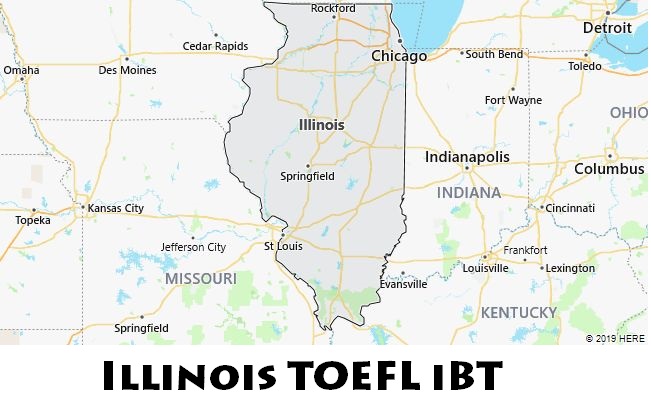
The TOEFL iBT test is offered in the state of Illinois. The list below shows testing locations for computer based TOEFL exam. Please scroll down to find the most up-to-date list of available test centers (including addresses) in Illinois.
- Peoria – N University – APCN-3207
7501 N University, Suite 218,
Peoria, Illinois 61614 United States - Springfield – Decatur, IL – APCN-3230
2405 E Federal Dr,
Decatur, Illinois 62526 United States - PROMETRIC TEST CENTER – APCN-3003
U Of I Testing Center – Illini Plaza, 1819 S Neil St. – Suite B,
Champaign, Illinois 61820 United States - Urbana Adult Education Center – STN15537A
211 N Race St,
Urbana, Illinois 61801 United States - Prometric Test Center – APCN-3212
3033 W. Jefferson, Suite 219,
Joliet, Illinois 60435 United States - ELS Language Centers – De Kalb – STN13839A
Student Health Services Building, Third Floor Room 307, 385 Wirtz Drive,
De Kalb, Illinois 60115 United States - De Kalb – Sycamore – APCN-3201
1830 Mediterranean Dr, Suite 201,
Sycamore, Illinois 60178 United States

Illinois Area Codes
Short for IL, Illinois was admitted to United States on 12/03/1818. The capital city is Springfield. With an area of 149,998 km², Illinois has a population of 12,801,539. The population density is 85.34 people per km².
History of Illinois
On the territory of the modern state Illinois, the American Indians lived at least seven thousand years ago. In the 7th – 15th centuries, not far from the modern city of Collinsville (and St. Louis, Missouri – on the other side of the Mississippi River) was located the settlement of Cahokia, which at that time was the largest city in North America. The residents of Cahokia (and many other Indian settlements in Illinois) belonged to the so-called “Mississippian culture”. They were characterized by a complex social structure of society, stretching from the Great Lakes to the Gulf of Mexico trade network, developed agriculture with corn as the main crop. A characteristic feature of the Indian settlements was the construction of earth mounds (mounds), on the flat tops of which residential and religious buildings were built. There were more than one hundred and twenty such mounds in Cahokia, about eighty of them have survived to this day (the largest of them is known as Monks Mound – “Monk’s Mound”). As one of the largest archaeological sites in America.
The first Europeans to explore the lands of the “Prairie State” were the French Jacques Marquette and Louis Jollier. In 1673 they went up the Illinois River and scouted a route to Lake Michigan. In 1680, not far from the modern city of Peoria, the famous French pioneer René de La Salle founded the first European settlement in Illinois – Fort Kreveker. It did not last long, only a few months, but two years later, in 1682, the French built a new fort, St. Louis, on the banks of the Illinois River. Perched on a high hill, this log-palisade settlement served as a base for French soldiers, hunters and merchants for several decades. Today, on the site of Fort St. Louis, there is a very popular tourist park in Illinois, Starved Rock.
The French practically did not master the “Country of Illinois” (as they called at that time the territory of the modern states of Illinois and, in part, Indiana and Missouri), limiting themselves only to hunting and trading with the Indians. In 1763, after the end of the French and Indian War, the rights to the lands of Illinois (as well as all the North American colonies of France located east of the Mississippi) passed to Great Britain.
During the American Revolutionary War, Kentucky militia leader George Clark led several very successful raids against British settlements in the “Illinois Country”. He practically met no resistance, since neither the Indians nor the few Europeans living in Illinois (mostly French-speaking) supported the British. The successes of George Clark, who earned the nickname “conqueror of the Old Northwest”, significantly strengthened the position of the United States in the region and helped George Washington (the future first President of the United States) enlist the support of France in the war with the former mother country.
In 1778, the government of Virginia announced the inclusion of the lands of Illinois seized by Clark into the state. In 1787, the US Congress decided to create the Northwest Territory, bounded by the Appalachians to the east and the Mississippi to the west, as well as the Great Lakes to the north and the Ohio River to the south. The new territory of the United States included, among other things, the lands of Illinois. In 1800, Illinois (along with the modern states of Indiana, Wisconsin, and parts of Minnesota, Michigan, and Ohio) became part of the Indiana Territory carved out of the Northwest Territory. In 1809 the US government created the Illinois Territory, which included, in addition to Illinois proper, Wisconsin, eastern Minnesota, and western Upper Michigan. On December 3, 1818, Illinois became the twenty-first state of the United States. The first capital of the new state was the city of Kaskaskia located on the Mississippi, in 1820 it was moved to Vandalia, and in 1839 to Springfield.
